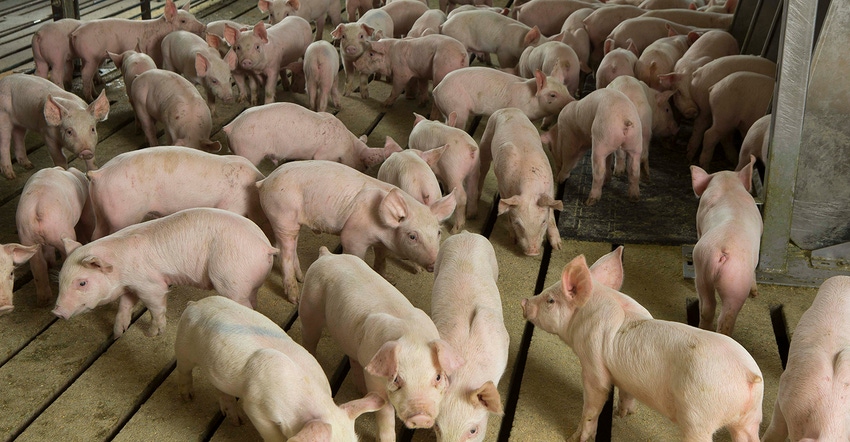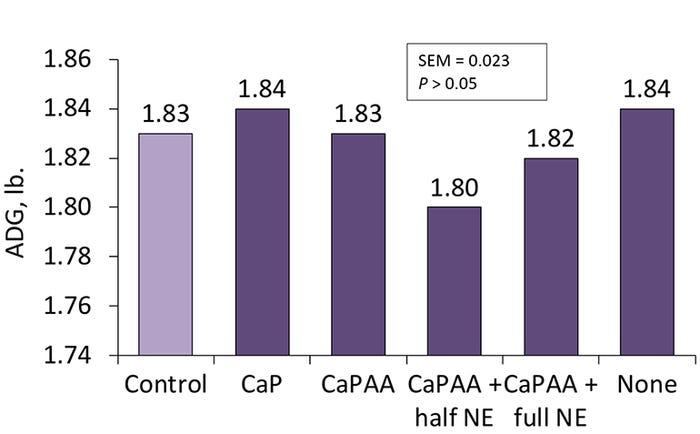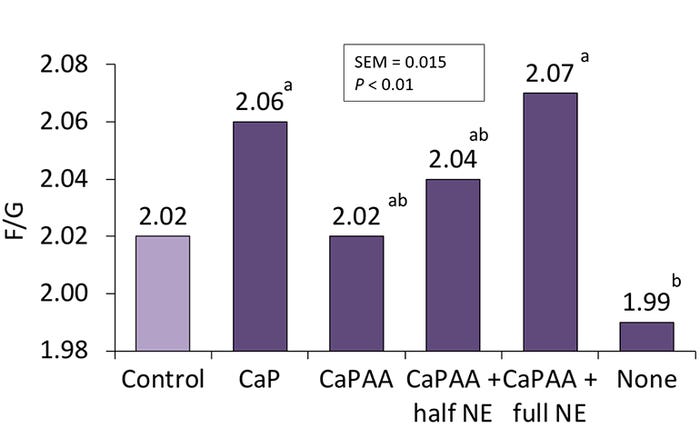Assessing phytase release values for growing-finishing pigs
Economically there was no evidence for difference in feed cost per pig or feed cost per pound gain.
January 9, 2020

Phytase is routinely used in swine diets as a means to increase phosphorus availability. Previous research has also demonstrated that high levels of phytase can improve the availability of other nutrients such as minerals, amino acids and energy. If added phytase indeed releases other nutrients in addition to phosphorus, crediting phytase with nutrient release values should allow nutritionists to decrease diet costs by reducing the amount of inorganic phosphorus and feed-grade amino acids used in a formulation.
However, there is limited data to confirm that the use of current nutrient release values, other than phosphorus, will maintain growth performance.
The objective of this study was to investigate the effects of feeding diets containing 1,500 phytase units of a phytase product from DSM Nutritional Products Inc. when credited with additional nutrient release values above calcium and phosphorus in diets for growing-finishing pigs. A total of 2,268 mixed gender pigs (PIC 337 × 1050, initially 62.9 pounds) were used in a 55-day growth trial at a commercial research wean-to-finish site in southwestern Minnesota.
Dietary treatments consisted of: A) Control (diet formulated with no added phytase); B) CaP (diet formulated to contain 1,500 FYT per kilogram assuming release values for Ca and P); C) CaPAA (diet formulated to contain 1,500 FYT per kilogram assuming release values for Ca, P and amino acids); D) CaPAA plus half net energy (diet formulated to contain 1,500 FYT per kilogram assuming release values for Ca, P, amino acids and half of the suggested net energy release); E) CaPAA plus full net energy (diet formulated to contain 1,500 FYT per kilogram assuming release values for Ca, P, amino acids and the full net energy release); and F) None (diet formulated to contain 1,500 FYT per kilogram assuming no release values).

Treatments were fed in two different phases. Phase 1 diets were fed from Day 0 to 29 (62.9 to 112.6 pounds) and Phase 2 diets were fed from Day 29 to 55 (112.6 to 159.7 pounds). The assumed release values used in diet formulation were 0.146% standardized total tract digestible P, 0.102% standardized total tract digestible Ca, 19 kilocalories per pound of net energy, and 0.0217, 0.0003, 0.00886, 0.0224, 0.0056, 0.0122 and 0.0163% digestible lysine, methionine, methionine plus cystine, threonine, tryptophan, isoleucine and valine, respectively.

For the overall feeding period (Day 0 to 55), there was no evidence for difference in average daily gain or average daily feed intake between the different diets fed. However, pigs fed the diet containing 1,500 FYT per kilogram assuming no nutrient release had improved feed efficiency compared to pigs fed diets containing 1,500 FYT per kilogram assuming either CaP or CaPAA plus full net energy release, with others intermediate. Economically there was no evidence for difference in feed cost per pig or feed cost per pound gain.
In summary, pigs fed full matrix release values had the poorest feed efficiency, while pigs fed diets assuming CaPAA plus half net energy had feed efficiency comparable to the control. This suggests the full matrix release values, especially energy, attributed to the phytase may be too aggressive and resulted in diets contributing fewer nutrients than needed to optimize performance.
Sources: Madie R. Wensley, Jason C. Woodworth, Joel M. DeRouchey, Mike D. Tokach, Steve S. Dritz and Robert D. Goodband, who are solely responsible for the information provided, and wholly own the information. Informa Business Media and all its subsidiaries are not responsible for any of the content contained in this information asset.
You May Also Like



